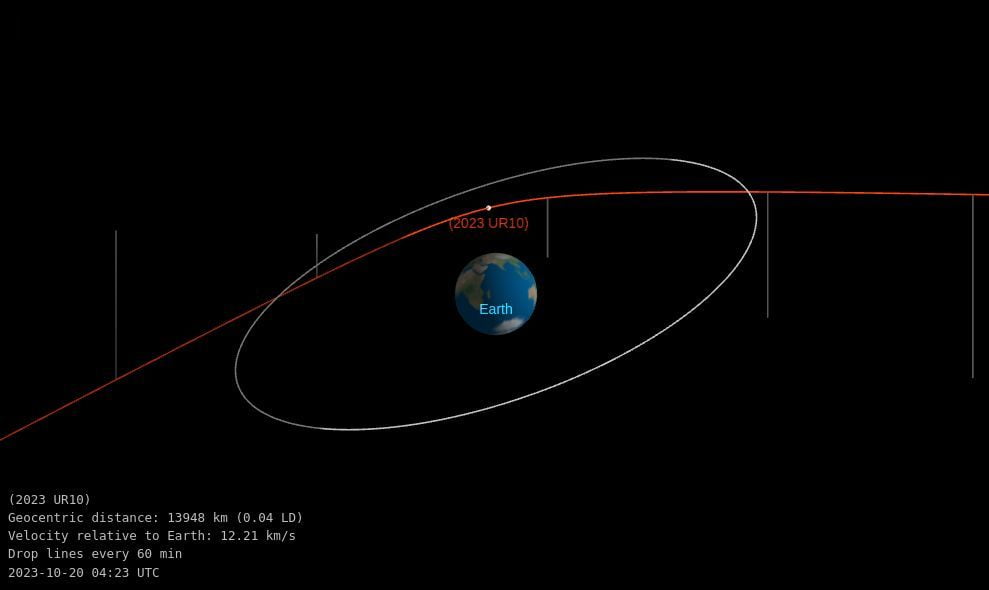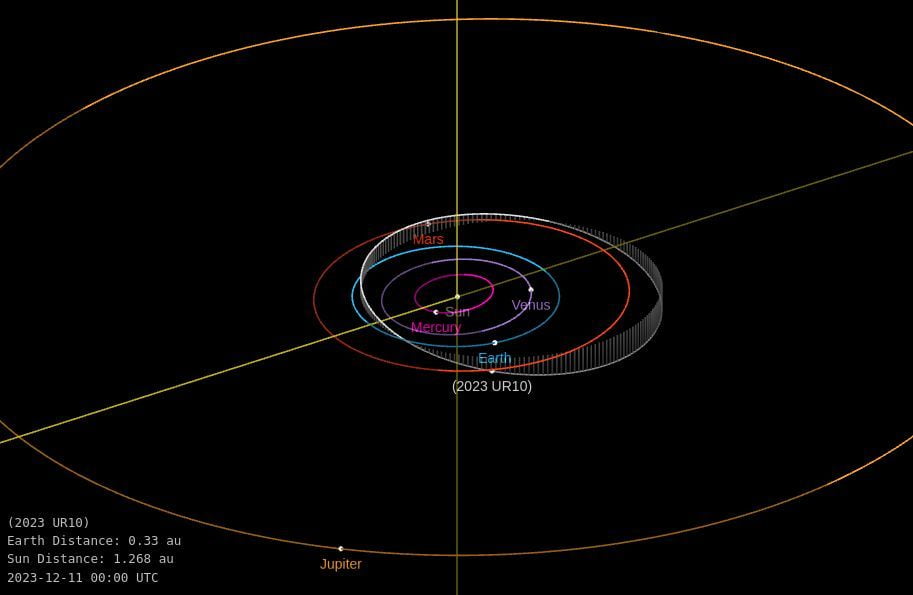A newly-discovered asteroid designated 2023 UR10 flew past Earth at just 0.036 LD / 0.00009 AU (13 951 km / 8 669 miles) from the center of our planet at 04:27 UTC on October 20, 2023. This is about 7 580 km (4 709 miles) from the surface.
2023 UR10 was first observed at Pan-STARRS 1, Haleakala, Hawaii on October 21 — one day after it made its close approach to our planet.
Its estimated diameter is between 2.7 and 6 m (8.8 – 19.7 feet)
Since the beginning of the year, our space observatories have identified a total of 86 asteroids whose orbits come within 1 lunar distance from Earth’s center.
2023 UR10 is the 9th closest known asteroid flyby on record (since 1900) and the third asteroid discovered in 2023 to enter the list of the top 10 closest flybys on record.
The closest known flyby was that of the asteroid 2020 VT4, which came within 0.00005 AU from the center of Earth on November 13, 2020. The asteroid had a relative velocity of 13.43 km/s and a diameter estimated between 5 and 11 m (16.4 – 36 feet). Another example is 2021 UA1, which ranks as the 2nd closest flyby, coming within 0.00006 AU on October 25, 2021, with a relative velocity of 15.84 km/s and a diameter between 1.1 and 2.5 m (3.6 – 8.2 feet).
Alongside 2023 UR10, which is the 9th closest flyby, there are two other asteroids making the list in the same year — 2023 RS and 2023 BU.
2023 RS flew past us on September 7, 2023, at 14:26 UTC, with a nominal distance of 0.00007 AU and a relative velocity of 13.59 km/s. Its estimated diameter ranges from 0.91 to 2 m (2.9 – 6.6 feet), making it one of the smaller asteroids on the list. It ranks 4th in terms of closeness to Earth.
2023 BU flew past us on January 27 at 00:29 UTC. It had a nominal distance of ~0.00007 AU and a much slower relative velocity of 9.27 km/s. Its estimated diameter ranges between 3.1 and 6.9 m (10.2 – 22.6 feet). It ranks 5th on the list of closest flybys.
| Rank | Object | Close-Approach (CA) Date | CA Distance Nominal (au) | V relative (km/s) | Diameter |
|---|---|---|---|---|---|
| 1 | 2020 VT4 | November 13, 2020 at 17:21 UTC | 0.00005 | 13.43 | 5.0 m – 11 m |
| 2 | 2021 UA1 | October 25, 2021 at 03:07 UTC | 0.00006 | 15.84 | 1.1 m – 2.5 m |
| 3 | 2020 QG | August 16, 2020 at 04:09 UTC | 0.00006 | 12.33 | 2.8 m – 6.2 m |
| 4 | 2023 RS | September 07, 2023 at 14:26 UTC | 0.00007 | 13.59 | 0.91 m – 2.0 m |
| 5 | 2023 BU | January 27, 2023 at 00:29 UTC | 0.00007 | 9.27 | 3.1 m – 6.9 m |
| 6 | 2019 UN13 | October 31, 2019 at 14:45 UTC | 0.00008 | 12.85 | 1.1 m – 2.4 m |
| 7 | 2011 CQ1 | February 04, 2011 at 19:39 UTC | 0.00008 | 9.69 | 1.0 m – 2.3 m |
| 8 | 2008 TS26 | October 09, 2008 at 03:30 UTC | 0.00008 | 15.76 | 0.61 m – 1.4 m |
| 9 | 2023 UR10 | October 20, 2023 at 04:27 UTC | 0.00009 | 12.22 | 2.7 m – 6.0 m |
| 10 | 2021 SP | September 17, 2021 at 11:50 UTC | 0.00009 | 14.37 | 3.7 m – 8.3 m |



References:
Asteroid 2023 UR10 at Minor Planet Center; at CNEOS
Featured image credit: CNEOS
If you value what we do here, create your ad-free account and support our journalism.
Asteroid 2023 VB2 flew past Earth at 0.085 LD
Tuesday, November 7, 2023
Asteroid 2023 VA flew past Earth at just 0.07 LD
Monday, November 6, 2023
Asteroid 2023 UH9 flew past Earth at 0.2 LD
Thursday, October 26, 2023
Asteroid 2023 UB flew past Earth at 0.15 LD
Tuesday, October 17, 2023
Asteroid 2023 TO17 flew past Earth at 0.14 LD
Tuesday, October 17, 2023
Asteroid 2023 TV3 to fly past Earth at 0.2 LD
Monday, October 9, 2023
Asteroid 2023 SH7 flew past Earth at 0.1 LD
Friday, October 6, 2023